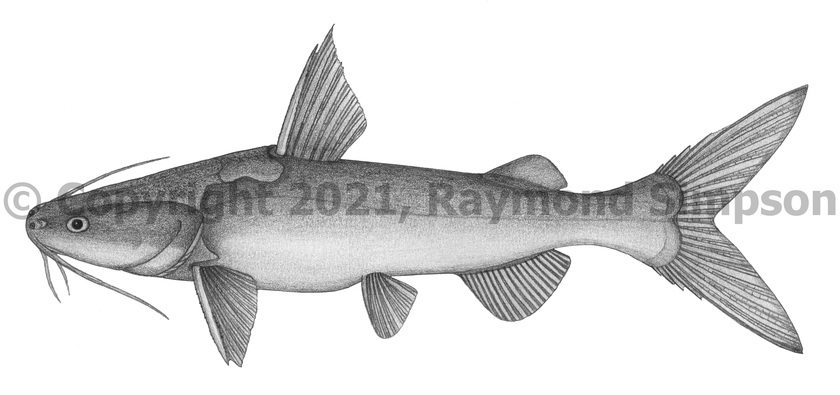
Common Name
Bressou Sea Catfish
Year Described
Valenciennes, 1840
Identification
Dorsal Fin: I, 7
Anal Fin: 17-20
Pectoral Fin: 9-11 rays
Pelvic Fin: 6
Caudal Fin: 13 branched (6 upper, 7 lower)
Gill Rakers: 11-14 on first arch
Aspistor is defined by the combination of the following characters described in Marceniuk & van der Steen (2017): medial fleshy groove absent, fenestra moderately well developed between frontal and lateral ethmoid, posterior cranial fontanel moderately developed, epiooccipital projecting into dorsal shield, occipital process short but wide at base (broadly contacting nuchal shield), nuchal shield very large and butterfly shaped, vomerine tooth patch present, accessory tooth plates very long, and adipose fin as long as anal fin.
Body elongate and robust with a strongly arched back. Head slightly flattened. Greatest body depth at dorsal fin. Snout broadly rounded. Nostrils not connected by a furrow. Anterior nostril fleshy and posterior covered by a flap. Cephalic shield broad and bumpy with anterior extensions that extend to the anterior margin of eyes. Smooth depression on dorsal midline of shield between eyes but no median groove or ridge. Supraoccipital process short with a wide base. Nuchal plate very large (almost as broad as head shield and butterfly shaped with a broad contact point with supraoccipital process (compare to A. luniscutis which is relatively smaller with less contact). Epiooccipital margin with a distinct notch. Nuchal plate with rough central area and smooth edges. Snout squared off. Mouth subterminal. Eye relatively large. There are three pairs of barbels (one maxillary and 2 mental) with the maxillary barbel barely reaching the pectoral fin. A single arched patch of villiform teeth cross maxillary. Vomerine tooth patch present. Accessory patches very long, forming an elongate U-shaped patch with the vomerine patch. Dorsal fin high with a strong serrated spine. Pectoral fins about the same size as dorsal fin with strong, weakly serrated spines. Pelvic and anal fins located far back on body. Adipose fin present over anal fin base. Caudal fin strongly forked. Body naked.
Color
Body dark olive to brownish yellow dorsally, grading quickly to whitish-yellow to golden below. Fins similar in hue to dorsum.
Size
Maximum size to 50cm, but mostly less than 30cm TL.
Habitat
A fully marine species found in turbid waters of inner continental shelves. Rarely found inshore in estuaries or mangrove areas.
Range
Known from eastern Venezuela to northeastern Brazil (Maranhao State). Known from the Amazonian and Orinoco plume area.
References
Acero, A. 2002. Ariidae (pp 831-852). In: Carpenter. 2002. The living marine resources of the Western Central Atlantic. Vol. 2: Bony fishes part 1 (Acipenseridae-Grammatidae). FAO Species Identification Guides for Fisheries Purposes. American Society of Ichthyologists and Herpetologists Special Publication No. 5.
Marceniuk, A.P. & van der Steen, P. 2017. Family Ariidae. In: van der Sleen, P., & Albert, J.S. (Eds.). 2017. Field guide to the fishes of the Amazon, Orinoco, and Guianas (Vol. 115). Princeton University Press.
Marceniuk, A.P., Burlamaqui, T.C.T., Oliveira, C., Carneiro, J., Soares, B.E., & Sales, J.B.D.L. 2019. Incipient speciation, driven by distinct environmental conditions, in the marine catfishes of the genus Aspistor (Siluriformes, Ariidae), from the Atlantic coast of South America. Journal of Zoological Systematics and Evolutionary Research, 57(2), 400-417.
Other Notes
Largely allopatric with the related Aspistor luniscutis, with a small contact zone in northeastern Brazil where hybrids are occasionally found. The two species are closely related and clearly represent an incipient speciation event based on ecological and behavioral isolation (Marceniuk et al., 2019). Besides range, the two species have different sized and shaped nuchal plates, epioccipital margins, and different degrees of contact between the nuchal and cephalic plates. They are also different in coloration and habits.